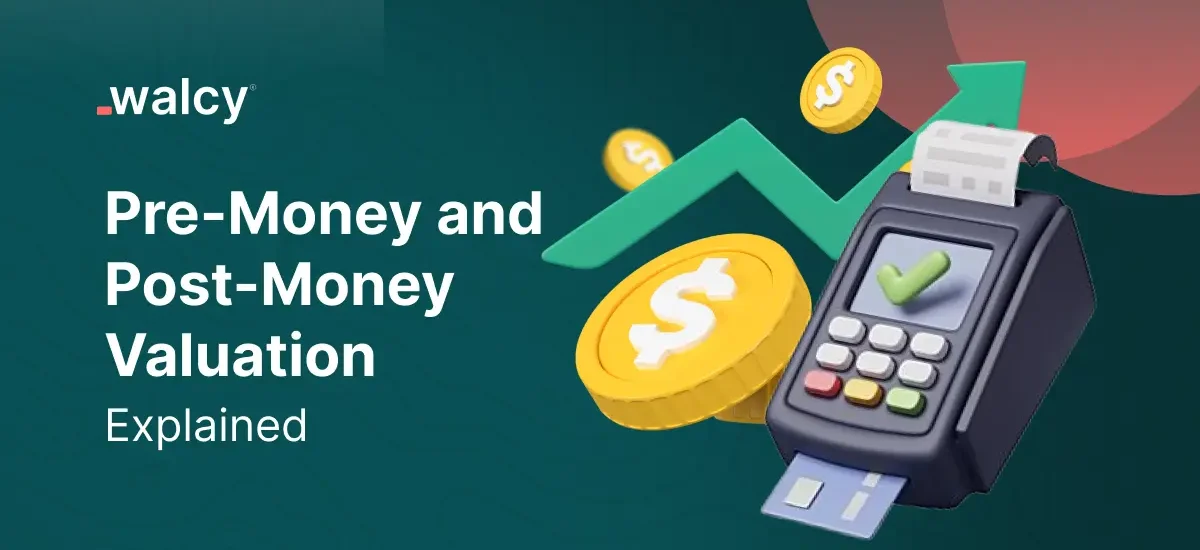The terms pre‐money and post‐money valuation are two of the fundamental terminologies originating from the start-up and venture capital universe. Every entrepreneur or investor should understand how valuation works. Two major concepts about funding that often people know are pre-money and post-money valuations. Most critical is that they end up very useful at the deal negotiation negotiations, and, in reality, how much a company is worth before and after an investment.
The definitions of pre-money and post-money valuation, their distinctions, their methods of calculation, and their roles in the entire funding process will all be covered in this article.
What is Pre-Money Valuation?
The pre-money valuation refers to the value of a company built before investing in it. If your business is based on a possible assessment regarding the business model, revenues, market potential, assets, and overall health of financials, this is what the business is worth at this time. Again, this pre-money valuation figure is vital during investment negotiation, since it will ascertain the percentage interest in ownership that the new investors will have concerning the capital that will be injected.
In essence, it is the value of a company after an investment has been made in it. So, sticking to the previous example, if the agreed-upon value of a startup after the $2 million investment is made is $10 million, then $10 million is the pre-money valuation.
What Are Post-Money Valuations?
Post-money valuation is the value of a company after the company has received a new outside investment, characterized as an addition of pre-money valuation, and the value of received new investment. Is the value of a particular company immediately following the addition of the funds after a round of funding has occurred? The investor would then determine how much to sell in ownership equity to new investors to have a controlling interest in the company.
If a corporation is attributed a pre-money worth of $5 million and a person wishes to invest $2 million, the post-money worth for that specific corporation will now be $7 million. Now, this $7 million completely represents the wholeness of the worth of the corporation plus the addition of new capital.
Pre-money vs. Post-money Valuation
Knowing the difference between pre-money and post-money valuations is as pertinent for an entrepreneur as it is for an investor. The two numbers may be closely interconnected, but they do play different roles in the valuation process.
Pre-Money Valuation: This refers to the value or worth of the company at this point before any form of investment. It is, therefore used to determine how much of the company the new investors will own.
Post-Money Valuation: This means the value of the company after the investment has taken place, meaning that this is the total amount of the pre-money value plus the new capital. Again, in lay terms, this is one of the value numbers showing the full total value of the company after the current funding round.
The difference between pre-money and post-money valuation lies at the point where both of them are calculated and driven: pre-money value sets the equity percentage going to the investors, and post-money value helps in knowing the overall worth of the company after the investment is made.
The importance of Pre-Money and Post-Money Valuation
The terms pre-money and post-money valuation are significant for the following reasons:
Ownership Stakes: One major reason pre-money and post-money valuations are strongly considered and used is in the establishment of the percentage of ownership that new investors are going to be receiving in return for the investment they are going to be infusing money into. The pre-money valuation represents that which the investor is going to own in the value of the company; the post-money valuation, on the other hand, shows the value of the company after the investment.
Negotiation Shield: Knowledge of valuations like this is very necessary for both the entrepreneur and the investor while negotiating a fund-raising transaction. For example, entrepreneurs and early investors hope to maximize pre-money valuation to minimize equity dilution, and late investors or venture capitalists do their best to justify post-money valuation to impress their LPs. These are hence pretty common terms used in such negotiations: pre-money and post-money valuations; hence, the communication is clear-cut for everybody.
The Impact on Future Fundraising: The post-money valuation defines a new benchmark for the next capital raising. Being overvalued at the early stage, the mean valuation allows a possible scenario when funds can be raised at a valuation greater than its actual one, but later on, the company can face problems with collecting further funds at the mean valuation. In other words, it causes a devaluation that reputationally brings negative effects to a company and can hold it back in the future.
Exit Strategies and Returns: This information is critical to the investor because it will help him do proper calculations on possible returns on investment. In the event of acquisition or listing, the post-monetary value will help secure the enterprise value of the investors’ shares and systemically say how much the shares amount to and how much the entire return of investment is. Due valuation is hence necessary for exit planning and eventual profit guarantee.
Business Strategy Implementation: A well-articulated understanding of a company’s valuation may also tilt the hand that the company pursues on its business strategy. For instance, in a case where the pre-money valuation comes out to be lower than previously thought, a firm might have the temptation to build more value before hitting the road to seek funding. The post-money valuation may be high; therefore, such a firm could ride that momentum to scale operations.
Employee Equity and Incentives: Most startups compensate employees with stock options or an offering in equity as outstanding shares. Such stock options or equity greatly depend on the company’s post-money valuation. A substantial post-money valuation would mean evoking the possible value of the employees’ equity, the measure being powerful enough to keep with the firm the best-performing employees.
Common Valuation Pitfalls
While being crucial to understand, there are a few common pitfalls with pre-money and post-money valuations that an entrepreneur or investor needs to be cautious of:
Overvaluation: The most apparent and biggest risk is the overvaluation of the company in early rounds of funding. Companies pitch with very hyped, inflated pre-money valuations, which might translate into unrealistic expectations of growth in the future, and this could, in turn, cause difficulties in meeting more capital at later stages. The result of these overvaluations is a down round, meaning that the company is seen as having lost value, which creates the impression that in the first place, the company was overvalued, being nothing but a disservice to the company.
Undervaluation: Contrary to that, undervaluing a company might result in total dilution of the ownership of a founder to lose shares in the company to worthless parties. Such an act may discourage the founding team and bring a short-term mindset to working for the company. The determination of the founding team will not be hard enough in that case.
Ignoring Market Conditions: Valuations are dynamic and could be determined by the market conditions at large. Economic downturns, changes in industry trends, or shifts in investor sentiment could all impact a company’s valuation. Consider these reasons when negotiating pre-money and post-money valuations to ensure that your valuation is on par with what’s going on in the market.
Miscommunication: Valuation can only be successful with proper communication between the entrepreneurs and the investors. Both parties should be in a position to understand how they arrived at the valuation and what it comprises. Miscommunication may birth disputes between parties, which will destroy the relationships between the founders and investors.
Conclusion
Any person associated with the startup ecosystem has to know about pre-money and post-money valuation. It not only is indicative of the shareholding pattern but also forms a very critical basis for negotiation, planning of subsequent rounds of funding, and the exit strategy for the run.
This will also give an entrepreneur an upper hand in fundraising since the investor has an adequate place to decide what every investment is about. Both parties will be able to get a full explanation of pre-money and post-money valuations that will meet their financial goals and contribute toward building a successful company in the long run.
Read more about: Expanding business internationally; Things to know.
Do follow us on Facebook and LinkedIn, to stay connected with us.



